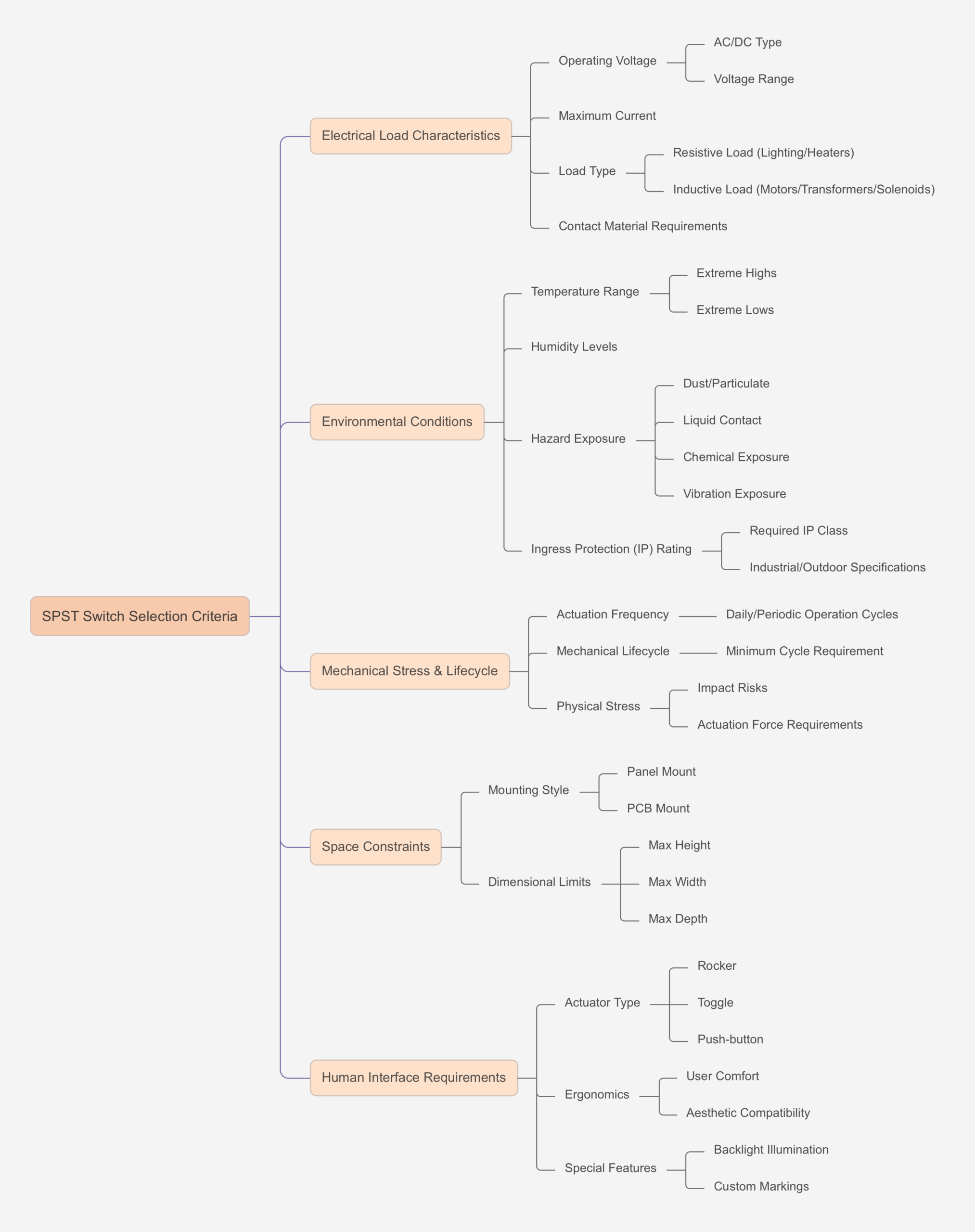Selecting the ideal Single Pole Single Throw (SPST) switch for a specific B2B application is a strategic process that requires careful consideration of various factors. It’s not merely about finding a switch that turns a circuit ON or OFF; it’s about ensuring that the chosen electrical component aligns perfectly with the application’s demands for performance, reliability, safety, and cost-effectiveness. For B2B procurement teams and engineers, a methodical approach to SPST switch selection can prevent costly redesigns, reduce field failures, and enhance overall product quality. This section outlines a step-by-step process to guide you in choosing the right SPST switch for your needs, ensuring you source a component that truly fits your industrial or commercial requirements.
Step 1: Defining Your Application Requirements
The foundation of any successful component selection is a clear and comprehensive understanding of the application’s specific needs. Before even looking at SPST switch datasheets, take the time to define the following critical parameters for your project:
- Electrical Load Characteristics:What is the operating voltage (AC/DC) and maximum current the SPST switch will need to handle? Is the load resistive (e.g., lighting, heaters) or inductive (e.g., motors, solenoids, transformers)? Understanding the nature of the load is crucial for selecting a switch with appropriate electrical ratings and contact materials.
- Environmental Conditions:Where will the SPST switch operate? Will it be exposed to extreme temperatures, humidity, dust, moisture, chemicals, or vibration? Define the required operating temperature range and any necessary IP rating for ingress protection. This is especially critical for industrial switches and outdoor commercial switches.
- Mechanical Stress and Expected Lifecycle:How often will the SPST switch be actuated? What is the expected mechanical life (number of cycles) required for the application? Is there any risk of physical impact or high actuator force?
- Space Constraints:What are the physical dimensions available for the SPST switch? Are there specific limitations on height, width, or depth? This will influence the choice of actuator type and mounting style (e.g., panel mount, PCB mount).
- User Interface Needs:How will the user interact with the SPST switch? Is a specific actuator type (e.g., rocker, toggle, push-button) preferred for ergonomic reasons or to match existing equipment aesthetics? Are there requirements for illumination or specific markings on the actuator?
Thoroughly documenting these requirements will create a clear profile of the ideal SPST switch for your application, making the subsequent selection steps more efficient and targeted.

Step 2: Key Questions to Ask Your SPST Switch Supplier
Once you have a clear understanding of your application requirements, engaging with potential SPST switch suppliers becomes the next crucial step. A reliable supplier is more than just a vendor; they are a partner who can provide valuable insights and support. When discussing your needs, consider asking the following questions, particularly relevant for B2B procurement:
- What is the typical mechanical lifeand electrical life of this SPST switch under our specified load conditions?
- Can you provide detailed test reports or certifications (e.g., UL, CE, RoHS, REACH) for this SPST switch?
- What quality control processes do you have in place to ensure consistent SPST switchperformance?
- What are the standard lead times for this SPST switch, both for sample quantities and bulk orders?
- Do you offer technical support if we encounter integration challenges with this SPST switch?
- Are there any known limitations or common failure modes for this SPST switchin applications similar to ours?
- Can you provide information on the long-term availability and obsolescence policy for this SPST switchmodel?
- What are your capabilities for customizationif our requirements are slightly outside the standard SPST specifications?
Asking these questions will help you gauge not only the suitability of the SPST switch itself but also the reliability and supportiveness of the supplier, which are critical factors for long-term B2B partnerships.
Step 3: Understanding Datasheets – Beyond the Basics
Manufacturer datasheets are the primary source of technical information for SPST switches. However, effectively interpreting these documents requires looking beyond just the headline SPST specifications. For B2B buyers, it’s important to delve deeper:
- Verify All Critical Ratings:Ensure that all key electrical ratings (voltage, current for specific load types), mechanical life, electrical life, and environmental ratings (temperature, IP rating) meet or exceed your defined application requirements.
- Examine Derating Curves (if applicable):For some SPST switches, especially those intended for demanding loads or temperatures, datasheets may provide derating curves. These curves show how the switch’s current-carrying capacity might need to be reduced (derated) under certain operating conditions (e.g., high ambient temperature) to ensure reliability. Understanding these curves is crucial for applications pushing the limits of standard ratings.
- Note Material Specifications:Pay attention to the specified contact material, actuator material, and housing material. Ensure these are suitable for your application’s environment and expected lifespan.
- Check Dimensional Drawings and Mounting Details:Carefully review the mechanical drawings to confirm the SPST switch will fit your available space and that the mounting option (e.g., panel cutout dimensions, PCB footprint) is compatible with your design.
- Look for Application Notes or Warnings:Some datasheets may include specific application notes, recommended usage guidelines, or warnings about limitations. These can provide valuable insights for successful integration.
Don’t hesitate to contact the supplier’s technical support for clarification on any datasheet information that is unclear or seems incomplete for your B2B needs.
Step 4: Requesting Samples and Prototyping
No matter how thoroughly you review datasheets and consult with suppliers, there is no substitute for real-world testing. Before committing to a bulk order, always request samples of the shortlisted SPST switches for evaluation and prototyping. This step is critical for several reasons:
- Verify Fit and Form:Physically check if the SPST switch fits your design and if the actuator style and feel meet your expectations.
- Test Performance in Application:Integrate the sample SPST switches into a prototype of your product or system and test their performance under actual operating conditions, including electrical load and environmental stresses.
- Assess Durability:If possible, conduct accelerated life testing or cycle testing on the samples to get a practical sense of their mechanical and electrical life in your specific application.
- Evaluate Ease of Assembly:Assess how easily the SPST switch can be installed and wired during your manufacturing process.
Prototyping with actual samples allows you to identify any potential issues early in the design cycle, saving significant time and cost down the line. It’s a crucial validation step in the strategic selection of SPST switches for any serious B2B project.
[CTA HOOK]: Need samples of high-reliability SPST switches for your critical project? Contact our specialists today! We can help you identify the best options from our extensive range of industrial and commercial switches and provide samples for your evaluation. ## H2: Beyond Off-the-Shelf: Customization and Bulk Order Solutions for SPST Switches
While standard, off-the-shelf Single Pole Single Throw (SPST) switches meet a vast range of B2B application needs, many industrial and commercial projects require more tailored solutions. Whether it’s a unique functional requirement, a specific aesthetic, or the logistical demands of large-scale production, partnering with a supplier who offers customization and robust bulk order capabilities can be a significant advantage. For B2B procurement teams and engineers, exploring these options can lead to optimized product designs, streamlined assembly processes, and improved supply chain efficiency. This section delves into the possibilities for customizing SPST switches and the benefits of strategic bulk purchasing.


